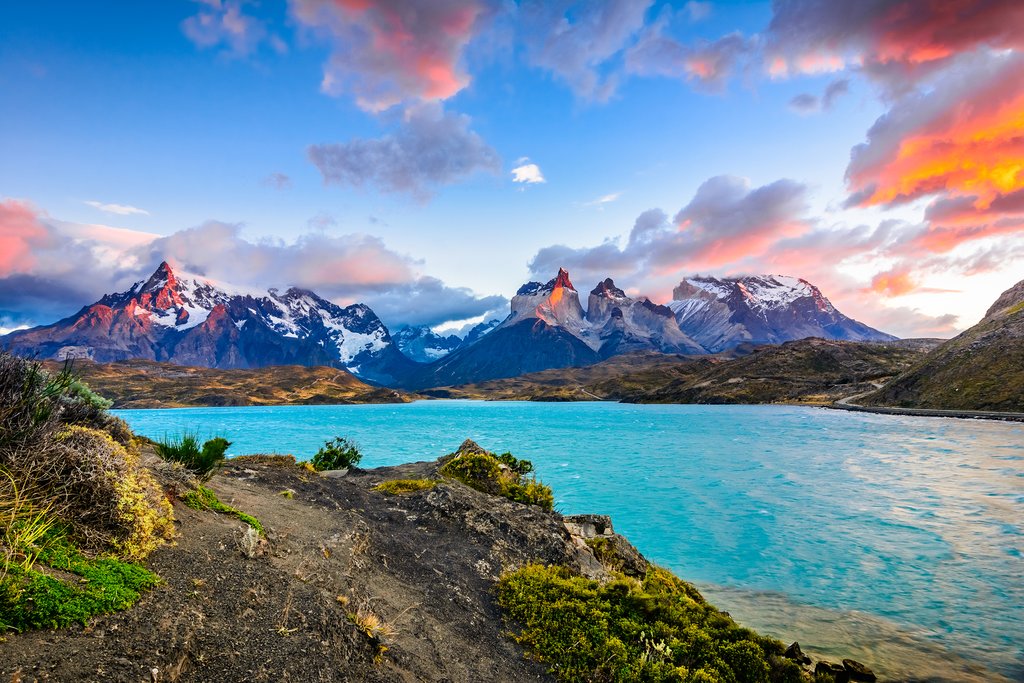Weather
September marks the official transition from winter to spring, though Patagonia can be slow to get the memo. In fact, spring doesn’t arrive until November, since daily highs remain the 40s, though September starts to see less rain and longer daylight hours for more outdoor adventures.
No matter where you travel, still bring plenty of warm clothing with you for chilly evening temperatures (after the sun goes down) and those unpredictable winds. If lucky, you might catch the beginning of wildflowers in Northern Patagonia, especially near the Lakes District, towards the end of the month.
Crowds & Costs
This is the start of shoulder season as the country moves into spring. If you can handle the persistent cool weather in certain areas (like Southern Patagonia), you'll beat the flood of international tourists (and pricey accommodation costs) of coming peak summer months. In any case, you'll want to make your reservations at least three months in advance to get the best deals.
If traveling in Chilean Patagonia, keep in mind that many locals travel for the country's Independence Day (September 18th) so this may see an uptake in prices at popular destinations.
Where to Go
Brave types who don't mind the pesky winter weather (keep in mind certain trails may be snow-covered) can head to Chile's Torres del Paine before the summer crowds. With staggering peaks, glaciers, and turquoise lakes, along with rare wildlife like guanacos and pumas, the UNESCO-listed park usually ranks high for travelers. Thanks to its remote Patagonian location and limited lodging choices, it remains relatively undisturbed, only receiving a fraction of the Machu Picchu crowds.
Another UNESCO-listed park—this time on the Argentine side of Patagonia—is Los Glaciares National Park. With staggering peaks and enormous glaciers, you'll likely base yourself in either El Calafate or El Chaltén depending on your activities of choice. Get here before the summer crowds arrive.
Chat with a local specialist who can help organize your trip.
What to Do
Ski season in the southern Andes may be coming to a close this month, but you can still get your fill of spring skiing in resorts on either side of the border.
For dry activities, stick to Northern Patagonia, where you may catch the first signs of wildflowers. Trails in the Lake District (both Chile and Argentina) will be uncrowded for hikers, bikers, and kayakers—just make sure to dress warmly.
If getting up close to marine life is appealing, you can head to Argentina's Peninsula Valdes and spot the southern right whale species during winter months, often seen breaching and showing off their prowess. Penguins can also be found in three different colonies along the coast of Peninsula Valdes, the largest being in Punta Tombo Rookery—home to more than 500,000 Magellan penguins.
In Los Glaciares National Park, trails may still be snow covered, but September is a great time to see the majestic Perito Moreno. This expansive ice mass flows down from the Andes out over the turquoise waters of Lago Argentino, ending abruptly in a great wall that curves around the lake.
Wait a bit and you'll witness "calving," the awe-inspiring sight of ice breaking off the facade and crashing into the tranquil waters below. You can trek on top of this glacier on a full-day excursion that involves walking over the ice while fully equipped with crampons and an ice ax.
Events in September
Chile's Independence Day Celebrations. Chilean Independence is feted during Fiestas Patrias (week of September 18), with a week of big barbecues, wine punch, and merrymaking all over Chile, including its southern region. These celebrations take place leading up to Independence Day in honor of significant historical events in regards to Chile's independence.
National Environment and Ecology Festival. Celebrated in Argentina's Ushuaia each September, this festival inspires reflection and action capable of correcting patterns of behavior that jeopardize the habitat in which life can develop. Look for events and lectures given by specialists.
National Ski Festival. In late September, Argentina's La Hoya Ski Resort dresses up to celebrate the National Ski Festival with contestants from all over the world. Events may include skiing, mountain biking, kayaking. In the evening, the mountain setting creates a beautiful setting for a range of shows drawing kids, adolescents, and grown-ups.
Traveling to Patagonia in September? Check out these great itineraries.
Wildlife & Nature in Patagonia. This 15-day tour in Argentine Patagonia hits the highlights between Puerto Madryn in the north to Ushuaia in the south for a range of outdoor activities and wildlife. On the itinerary are two national parks: Tierra del Fuego (rivers and ancient settlements) and Los Glaciares (glaciers and iconic hikes).
Patagonia & the Atacama Desert. After getting a taste of Santiago, fly north to the Atacama desert—an oasis in the driest part in the world known for geysers, moonscapes, and starry skies. Then fly all the way south to Patagonia's Punta Arenas where you'll meet a penguin colony before finishing in Torres del Paine National Park for a range of activities and wildlife viewing.
More Helpful Information
Patagonia in August
Patagonia in October
Best Time to Visit Patagonia
More Tours & Itineraries
